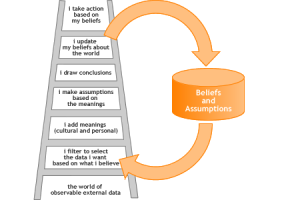Dear Readers,
I’ve attempted to write this post a number of times but somehow always became stuck. Perhaps I wasn’t ready then. I think I am now.
I have been writing this blog since 2009. It started because I had something to say about organizations and how they are led. I wanted to make some kind of contribution toward making not-so-good workplaces somehow better for people. And, I believe good workplaces always start with good leadership, the kind that puts value on the potential of people’s willingness to do their best work in environments of trust and mutual respect.
I surprised myself by having quite a lot to say on the subject, certainly between 2009 and 2013. In 2014, I mostly repeated myself, (a habit, I’m told that comes with age). Nonetheless, you managed to see something worth reading, something worth discussing and also passing along. That kind of surprised me too, but only in the best of ways. I am both grateful and delighted by your response to something that started out as this woman’s somewhat hesitant voice in the Cosmos.
But, here’s the thing. Just about everything has a beginning and an end. And “You’re Not the Boss of Me” has reached its end place. I‘m a bit sad about that. But I also believe that once you have said what you have to say, the best strategy is to simply shut up and listen to somebody else.
I have learned much from so many of you. I have come to know that there is a multitude of fine people who share my view of what is needed to build an effective, satisfying and profitable workplace in the 21st Century. These are leaders who are in the thick of it, leaders who see a vision for the future that includes all kinds of people; a vision that excites them, challenges them and rewards them generously for their efforts.
Leadership in organizations is not a spectator sport. It is, after all, not what we say but what we do that matters. And so, simply writing about it is not enough. I have been out of the workforce for some time now and in the years I have been writing this blog, have drawn on my past experience, on my own stories and other peoples’ and on current events. However, without actually being in the fray, there comes a time when one simply runs out of useful things to say.
It’s been fun. It has allowed me to make acquaintance with some really remarkable people whose passion for good leadership is unmatched.
You may be familiar with some of these very accomplished and dedicated people but just in case you aren’t, I’d like to point you in the direction of some of my favourites. Please follow them, read them, and learn from them. I have, and have become more enlightened because of it.
=================================
Mary Jo Asmus is a highly successful executive coach, writer and consultant with (at least in my observation) a kind of spidy sense when it comes to accurately assessing human behaviour. She and I have often written about very similar things and shared our ideas with each other on more than one occasion. I have always benefitted from these exchanges. Given the opportunity, so would you.
More about Mary Jo here: http://www.aspire-cs.com/who_we_are
Follow Mary Jo onTwitter: @mjasmus
===================================
Wally Bock: If you want to really understand what it takes to lead others, reading Wally’s blog is a must. His writing is refreshingly honest and full of lessons he learned himself, sometimes painfully. And if you want to learn to be a better writer, Wally can help you with that too.
More about Wally here: http://www.threestarleadership.com/about-wally
And here: http://writingabookwithwally.com/
Follow Wally onTwitter: @WallyBock
=================================
Dorothy Dalton is an impressive woman to say the least. She is an International talent management strategist and coach. She is also CEO of 3PlusInternational, an online company she founded together with Dr Anne Perschel in 2010.
More about Dorothy and 3Plus International here: http://3plusinternational.com/team/
Follow Dorothy on Twitter: @DorothyDalton
=================================
Lolly Daskal is Founder and President of “Lead From Within”. She teaches us the importance of bringing all of ourselves to leadership… to lead from the heart, and is a particularly successful coach, consultant, facilitator and author
More about Lolly here: http://www.lollydaskal.com/
Follow Lolly onTwitter: @LollyDaskal
=================================
Karen Hurt is Founder and CEO of Let’s Grow Leaders. In my observation, Karin’s common sense approach to leadership and her practical leadership experience in business earns her well-deserved attention. If you appreciate a ‘no BS ‘approach to leadership, you won’t go wrong by becoming a regular reader of her blog.
More About Karin Here: ~ http://letsgrowleaders.com/about/
Follow Karin on Twitter: @Letsgrowleaders
=================================
Susan Mazza was the first person to engage with me on this blog. Her words were encouraging and her ideas are always insightful. Susan not only has tons of business and leadership experience but a deep intuition about human beings and what makes us tick. I think that’s a powerful combination.
More about Susan here: http://randomactsofleadership.com/about-the-author
Follow Susan on Twitter: @SusanMazza
=================================
Tanveer Naseer is a fellow Canuck. He is also a scientist, writer, and consultant who can expertly examine complex human and business situations and make sense of them. I’d say we could all use the kind of insights he shares regularly on his blog.
More about Tanveer Here: http://www.tanveernaseer.com/about/
Follow Tanveer on Twitter: @TanveerNaseer
=================================
Jane Perdue: ~ There are many reasons you should consider reading what Jane has to say. If you’re looking for just one thing though, here it is. She believes in leading big and in challenging stereotypes and the status quo. If we are going to effect change in the way we lead, we need all the Jane Perdues we can get.
More about Jane here: http://braithwaiteinnovationgroup.com/leadbig/
Follow Jane on Twitter: @thehrgoddess
=================================
Anne Perschel: ~ I have to declare that Anne is a particular favourite of mine, both as a highly accomplished leadership and organizational psychologist and as a person. She is passionate about helping executives create workplaces that meet the needs of a 21st Century global marketplace. And, she is an especially strong advocate for women, co-founding 3Plus International with Dorothy Dalton.
More about Anne here: http://germaneconsulting.com/about/principle-consultants/
Follow Anne on Twitter: @bizshrink
=================================
Art Petty is a very classy guy. He was also one of the first people to give this blog, and me, some encouragement when I first started writing. He is an author, a teacher and a highly skilled executive coach. And, he is a gentleman of the first order.
More About Art here: http://artpetty.com/about/
Follow Art on Twitter: @artpetty
=================================
Jesse Lyn Stoner appears last on this list only as an unfortunate outcome of being further along in the alphabet than anyone else here. In all other ways, she gets an “A” from me. Jesse is a leadership consultant and best-selling author who champions the power that comes from developing organizational vision and collaborating with those affected by it in building effective, practical and actionable strategies.
More about Jesse here: http://seapointcenter.com/
Follow Jesse on Twitter: @JesseLynStoner
=================================
If this list leaves you wanting more, there is a wealth of knowledge at the Leadchange Group Site founded by Mike Henry Sr. (@mikehenrysr) and now under the capable leadership of Becky Robinson (@beckyrbnsn) as a division of her company, Weaving Influence.
=================================
As for me, I still plan to show up on Twitter and perhaps, from time to time, someone will allow me the privilege of writing as a guest on his or her blog. You never know, I might not be as “done” as I think I am. In fact, I may begin a whole new blog on an entirely different subject. Who knows?
Thank you so much for spending time here with me. It has meant a lot. Oh, and keep up the great work. The World needs you.
Sincerely,














